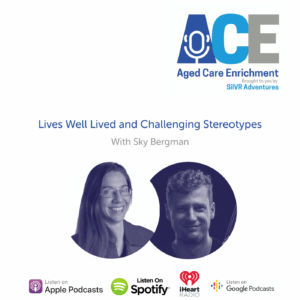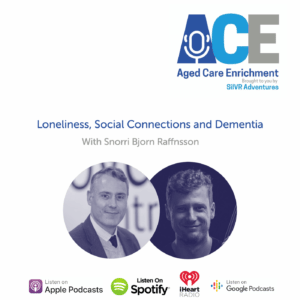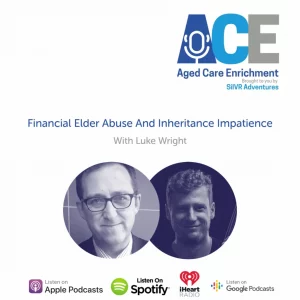Emi Kiyota is an ageing design expert and self described environmental gerontologist. Her work specialises in the design of buildings and spaces to support the older adults that use them.
Emi likes to use the metaphor of physical spaces are gloves and their users the hands. Without understanding how the hand moves and what it’s needs are, a supportive and effective glove can’t be created. And in the same way, when designing spaces we must first talk to users of that space. All too often, Emi says, we focus too much on the design needs of the care workers and not the care recipients.
Emi is also the founder of Ibasho, a not for profit organisation that has empowered elders in Japan, Nepal and the Phillipines to build their own communities. With a focus on self-sufficiency, inter-generational living and reciprocity these communities help elders maintain their value and identity as they age.
Transcript
Ash de Neef: Emi, thanks for joining us on the program today.
Emi Kiyota: Thank you for inviting me.
Ash de Neef: Yeah, it’s a pleasure. And can we start with a bit of your background and I believe that you’re an environmental gerontologist. What does that mean exactly?
Emi Kiyota: Very good question, actually. So an environmental gerontologist I must say when I was done with my PhD, there was no such thing as environmental gerontologist. But I studied architecture, but I focused on ageing. That’s where my graduate school program was throughout. And when I was done with my graduate work.
People were asking me, so what did you study? I said well, “I studied architecture, but very specialised on ageing.” I was talking about it and, at one point someone said, oh, “so are you an environmental gerontologist?” And I said, “that sounds great.” So that’s how I started to use environmental gerontologist.
But basically my background is an architecture – I studied architecture. But it’s very specifically on ageing and how design process can be changed. That was my interest. My interest is always been that, how can we bring users into a conversation of design process? So I wanted to study about it. If we could do it for the older population, who normally don’t have a critical voice about the design for their own places.
Ash de Neef: Yeah that’s fantastic. And a unique lens on the issues of ageing. So you worked on architecture, you study architecture and then after that you specialised in how that can be applied to an ageing population?
Emi Kiyota: No. my graduate program throughout, I took architecture. That was my degree, but I had minor or emphasis. So my thesis and dissertations are always ageing, that’s all I studied. So I did not really study much about school design or high rise. I really specifically was interested in ageing.
Ash de Neef: And maybe just jumping to design here. You’ve compared environments to gloves and people to the hands before. What did you mean by this metaphor?
Emi Kiyota: I was told by one of my beloved professor, Jerry Weissman. I always have to give him a credit because he’s just such a great mentor and he’s such a great advisor in my graduate work. So he was always using this metaphor of gloves and hands. When we design places for nursing home for example, the building is a glove and really organisation is a hand that moves.
So just try to design gloves, which is a design of place, you have to be able to understand how a hand moves, otherwise it just doesn’t fit. So we have to be able to understand that user, how they use that space and how operationally actually run the place. But also to look at how elders themselves use that space and just try to create a better experience of the space rather than a beautiful building that might not really give a sense of dignity or privacy or socialisation.
So I thought it was a brilliant way for him to explain to me because a lot of time when you’re in architecture, you just look at the building and that’s what you focus on, designing it. And forget about the fact that we actually designing for users. And users are not only operators, and what kind of experience that we want to bring by designing this glove so that the users feel that it’s a good fit with what they want to do.
Ash de Neef: Yeah, that’s fantastic. And it’s probably a challenge to, in some situations to balance what’s the user experience with what’s the experience of people who are working there and trying to find something that’s accommodating for everybody.
Emi Kiyota: Yeah, I think it’s easier to design residential homes because you have less people using it and they’re family most of the time, so you understand how they want to use the space. But when you’re in like hospitals and nursing homes, and those public buildings, lots of time that is a place for elders to live, it’s that the home. But at the same time, that is a workspace for staff members.
And then from operator’s perspective, that is a place they have to run as an organisation. So they are different interests, coming to each other to one space where you have to design, so It’s a balancing act for everything.
We have done a very good job in the past to provide safety, to provide a hygienic environment like hospitals. Because we looked at the environment from the point of view of running the organisation in a safe way. We didn’t pay enough attention to how we want elders experience this in the best way.
So that’s what I’ve been very much interested in bringing that into the conversation. Just what does optimal experience feel like, and look like from elders? And what can we do from architecture point of view to make that happen?
So do chandeliers do it? Or what does home-like mean? I always questioned about that. Does a luxury luxurious environment make people happy or what does home mean? It doesn’t have to be luxurious, but there is a sense of expectation and comfort that people get out of your home.
And I think we have to spend a little more time really try to understand what it is.
Ash de Neef: I really liked that, as you phrased it there, that we’ve spent a lot of time thinking about the operational needs of a home, of a care facility, but then not so much on the home aspect of it is.
Is the only way to get that approach by talking to people who are going to be living there?
Emi Kiyota: I think there are two critical directions of efforts that we have to go through. I think designers have to be able to accept the fact that we know everything. So we just have to learn to say, “we just have to ask elders what’s good”, and we bring our creativity to solve the problem. Rather than saying, “I can come up with beautiful design”, just like designing perfect place is for whom? You might be able to design the most beautiful place that make you feel happy, but if it’s really a perfect place for users? Maybe not. Who are we designing for?
I think we have educate the designer’s perspective and also we have to empower all the people to be able to say, “this is what we want.” It’s a simple thing, but it is hard in a society because a lot of elders are so conditioned for a long time that we are too old to say something. We have to be a cute grandma. Don’t complain and people are actually simply afraid of retaliation. If they said something that is not grateful.
So it is hard for them to really come out and just say, “this is what we want”. Because our ageist way of thinking pushed them into certain mindsets. So we really have to just help them to come up from like their own ageist thinking actually.
Ash de Neef: Yeah, that’s great. And something you’ve been doing your work in Ibasho is empowering older people to speak up and to create communities that they’re excited about. Can you talk to us about Ibasho? What does Ibasho mean first of all?
Emi Kiyota: Yeah. So I was born and raised in Japan and lived there for almost 30 years before I moved to the US. By the way I’m Japanese and living in America, so I’m still Japanese. So Ibasho is a Japanese word, It is a place where you feel at home being yourself.
I really like that terminology because when I was in the graduate school, I was always taught that we should design place home-like environments or home environments for the older people. And I was thinking home means so different. Especially someone like me, born and raised in Japan, any place in the US in an apartment, it’s not going to be my home. It is very different.
So I feel like, and also that the nursing home, it’s not going to be at home for lots of older people. It is a place to live, but calling it home to me, I feel like we’re fooling ourselves by saying it and just making us feel better to say we are designing home like environment.
Ibasho to me it is a permanent and also a temporary sort of concept or place where you feel at home. So it could be like a chair. It could be somewhere that you create your own space. It doesn’t have to be whole house or just a space where you go there and feel like, “this is a home, and that makes me feel at home.”
To me, that was a much more achievable goal and Ibasho to me, it was the right word.
But at the same time Ibasho means that you have to have your hands into creating the space. That’s not something that people can automatically receive because you kind of have to, bring your chair or you just create something. So that, makes it your own place.
And I feel like being involved in the design process. I was quite struck by the fact that we don’t listen to elders and ask elders what they want much. I really wanted to challenge me and also elders to ask and just try to wait until they tell me what they want. Because I think if I were to ask you question that, “how you want your old age life to be?” It’s hard to articulate isn’t it? You know what you don’t like, but it’s hard to articulate. And that means that we just don’t think about it consciously enough.
So yeah Ibasho I wanted to really sit down and ask elders what they really wanted and how I can help. The kind of things that they always already wanted to do. So that’s, how I started to work on it. Because I feel like when I was working on designing nursing homes and hospitals we think about like, “oh, we have to look after older people because we’re nice people.” It’s really one way, just like, “I’m kind person we have to help elders.”
But at the same time, when you go home, your mom wants to make tea. And do I want to say, “mom, you’re old sit back. I would just make one for you”. And my mom feels like, “oh, I’m old, so I can’t do it.” And I feel like that’s how we condition elders. So I feel like, if mom wants to do it, that makes her happy let her do it.
And that’s how I feel because in the nursing home, there are lots of other people I thought before I moved into a nursing home. I lived in a nursing home for three weeks for my graduate school. I thought, “oh, 85 years old can do it. I can do it for a few weeks.” And it was the really toughest experience I have to say.
Because you have to follow the structure that they tell you what to do, and you have to give up on all kinds of control. But I thought that older people would have much more frailty, yet when I met them, they were so wise, and they were just, full of experience in their life. But I feel like we are not serving justice for them because we are busy trying to help them without asking how they want to contribute to help me out.
So that’s how Ibasho actually started.
Ash de Neef: That’s great. And asking those questions and having that attitude led to creation of several communities around the world, right? So in Northern Japan, can you maybe tell us about the community in Northern Japan that you helped build.
Emi Kiyota: Yeah. That building was actually the first project that we did. We founded in Washington DC 10 years ago, it was way before the disaster happened in Japan. It was more than 10 years ago, actually. So when the earthquake hit and the tsunami happened because I’m from Japan and I really wanted to help them, but I didn’t know what to do.
And we had the funding from the US and said, “we want to help elders.” So we decided, I think it was 11 months later, I went to Northern Japan that was badly hit by the tsunami. The location, why I chose, was because one of my friends runs a nursing home there. So I wanted to also help her community too.
And so I went there and spoke to the elders and said, “just sit down.” We sat down in temporary housing communities and older people. And what we found out was that older people wanted to do something rather than being helped. I met an 85 years old woman through an access-tea event that people get together and they were about 50 years old, which is really young in the Japanese standard was serving tea.
And I was talking to this 85 year old woman, talking about such a black water like the tsunami came in, and she just cannot sleep with air conditioning sound because it’s very similar to what she remembers. And she was saying, “I’m so grateful that I have a house to live in, because of the temporary housing, I have food to eat and I have clothes to wear everybody helped us out. But it’s been 11 months. What I want is to give something back to them. If I can write a letter, I will. But I don’t know how to do it.”
So that’s why I got an idea of what can I do to empower her? And just those wishes are such simple ones, but it was something that she couldn’t solve. So I just wanted to say, “okay, maybe what older people want is to just really give back to the community, regardless of their physical and cognitive abilities, they have something to offer.”
So that’s how I created Ibasho. So that woman, and also there was a group of elders who resonated with that idea. Saying that, they are not for everybody because some people said, “I just want to sit back and being served”, but lots of elders actually wanted to have that opportunity to do something.
And I remember one of the elders was saying that, “I was actually surprised because all these international people they bring stuff. You guys didn’t bring anything, but sat down and asked us what we wanted to do.” To me I took it as a compliment, of course, like, “sorry that I didn’t bring anything”, but I was really interested in how I could help them to do to really empower them. Because I felt like, based on my learning in a nursing home, elders wanted to do something. So I just wanted to help.
So that’s how it started. So we applied eight principles of Ibasho and we created this place and we had very little budget, but people actually brought and donated lots of things to make that happen. You know, many people donated their time, whatever they brought from home, they still do that nowadays.
But it is not for me. It is a place for elders. And they decide everything. So they have their own operation, not-for-profit organisation and board members are all over 75 years old and they run the whole thing. And so now they have, we started with cafe because that’s what they wanted to create. They did not want a nursing home. They did not want adult’s day center. They wanted like a normal place where they can go and help young children.
That grew from cafe to organic farm and they quickly realise organic vegetables, they have to sell them. So they started bi-weekly farmer’s markets and they realised that, “oh, we have leftover vegetables”. So they started the ramen noodles shop and they do a daycare for children and just whatever they could do as a community elders and they’re kind of running it.
Ash de Neef: So when you were asking those questions and when they started experimenting with what they wanted to have in this community, was it a case of anything goes, it’s just, “what do you guys want and what will make you feel empowered?” Was that the sort of spirit behind it?
Emi Kiyota: Yeah. So we had this Ibasho principle, which is it has to be multi-generational and it has to be culturally appropriate. So we always said, and also we don’t want to make it as an institutional setting. So yeah, everything they think about is just always it’s not grandma’s cafe for grandmas, they wanted us to create grandma’s cafe for young people, basically.
So yeah, that’s really something that they tried to do. And I’m just helping, I don’t really have to do much these days because they are, I mean, older people used to be the school principals, and they used to work in the city halls. And so they write grants, because when you retire from college professor or, school principal, it doesn’t mean that you lose all your brain cells, you just don’t use them. But they know how to do it.
So to me it was a pleasant surprise. They exceeded everybody’s expectations, but it made me think about it, “sure, of course, because they’re all grown up, they have all this experience. Why can’t they do it?”
Ash de Neef: yeah. yeah. Awesome. So I’m guessing that sort of a self-sufficiency would be a feature of these communities as well.
Emi Kiyota: I think if you get something easily, it just doesn’t last – that positive impact for a long time. But because the elders really worked on it. So, they’re really proud of themselves. So they do everything in a self-sustainable way.
Of course they complain and say, “oh Emi, you make this place. So I’m so busy. I’m just can’t take a break.” And I say, “what are you going to do If you didn’t have this? You can close it, it’s not my place you can close it”. And they were like, “well, someone’s going to have to do it”.
But to me, that gives a sense of responsibilities in a right way. But I think self-sustainability is, to me it is a hard thing, but it is a key for older people to have a sense of pride.
Because, some people say they were like Ibasho-like cafes somewhere, and they were like, “they’re not self-sustainable we make all this operation money.” So I think it is a pride for them.
Ash de Neef: Yeah, fantastic. And something that I really like about the Ibasho concepts is that it’s really about community, as you said, and it’s about people doing it for themselves. And I’m wondering, what do you think can be achieved in a community setting that can’t be with governments or with, a lot of money coming from private corporations?
What are the strengths of communities like this?
Emi Kiyota: Yeah. I have been actually struggling with one thing. It’s just like try to help people define a positive role. Because, again our society conditioned us to think that older people we have to go and help – government has to go and help. So how can we actually help people to have a clear, positive role as an older person that can take a leadership role?
So I started to think lately that I do care about climate change. I do care about ageing. Can we just combine these and just empower older people to take a leadership role for environmental stewardship? That’s not going to cost that much money because they know the community and you know where to plant trees, how to live more environmentally friendly.
Why can’t we train elders to train their children or grandchildren so that they can have a positive role and they can actually leave a legacy behind. And to me it doesn’t cost that much to begin with. And Ibasho happened to be new constructions and people think it’s expensive, but it is a concept we can actually work with existing community based program. We can work with people through library.
It’s a mindset with talking about it just rather than just try to help elders. What can we do to empower elders, to take a leadership role and being able to help others?
I think that location-wise, that can be done anywhere.
Ash de Neef: I really like as well that the work you’re doing is positioned between full independence and full dependence.
And it’s building this network of interdependent people to help themselves. Do you think that this is a space that could expand over the coming years? This idea of independence, interdependence I should say?
Emi Kiyota: Yeah, I think that’s society is going that way. I think maybe because of the COVID I think things are changing. And also I think institutional care went one way so far, and then we saw this limitation of visitation for the sake of safety and then people realising that who is in control of my life? How do we want to live our life really, what community means?
We had a moment to be able to think like that, I think. So I’ve been hearing more and more that people prefer community settings and people prefer a walk-able community where you see people, you interact with people. So maybe I’m hoping that this inter-dependency concept is going to grow, but at the same time, some place like Ibasho might be helpful because we are just not used to how to do it.
So if we have opportunity, it just like people are probably willing to try it out if they could just plug in and try out. But if we have to start everything from scratch, it just gets a little difficult. So if I was hoping that, people wanting to stay at home means that people want to be connected to the community. Staying at home means that, you’re going to be staying at home, not seeing anyone. That’s not what ageing in place is all about.
So if some places like Ibasho will provide some elders who are rather healthy and maybe educated middle income, they don’t really belong to a nursing home. They don’t belong to an adult day center, but they want to do something for others. If Ibasho can create a space where people can exchange their ideas and do the things that they want to do together, I would love to be able to see that. Can you do that in Australia?
Ash de Neef: Yeah, I believe that we can. And maybe something that would, that help people, as you’re saying, if there’s a way to dip your toe into these ideas instead of having to build a new place from scratch, but maybe something that would help is, I know you mentioned there’s eight principles of Ibasho.
Could you give us a few of those and people can start to think about what it might mean?
Emi Kiyota: Yeah. So the first principle, I always feel like I’m repeating common sense, by the way, by saying there’s eight principles. Principle one is, older people are variable assets to the community. Principle two, creating informal gathering space, to create the normalcy rather than an institutional feeling.
Principle three is, community members drive development and implementation of the project. So we design construct together and they run and maintain the place we create. And principle four is, all generations are involved in the community. The community is not homogeneous. It’s supposed to be multi-generational, otherwise it’s not a community.
Principle five, residents participate in normal community life. So it is not like we are creating this place in the middle of nowhere. It’s beautiful greenery, but no one comes. That’s not the kind of place that we create. We wanted to set these Ibasho activities in the middle of the community where people can actually see what elders do.
And Principle number six, local culture and traditions are respected. Sometimes we forget all this local culture and traditions are significant. if you live there for a long time. But that kind of tradition can get lost very easily if you don’t pay attention. So that’s one of the things that we do is to protect that.
Principle number seven, communities are environmentally, economically and socially sustainable. It is just to create resilience. I think we always deal with like environmental sustainability and social sustainability separately. But those three are very highly integrated, so we just try to create this community. So everything they do is environmentally friendly and also, it is self-sustainable. So economically sustainable and it’s multi-generational and its very inclusiveness is something we practice, so that it’s socially sustainable.
The last one is growth of the community is organic and embraces imperfection gracefully. It is very Japanese. I’m not sure if you heard about wabi-sabi, which is a concept. It’s “real beauty lays on the top of some imperfections. So Japanese rice papers are beautiful, because it is not uniform. It has imperfection in it, that gives you a personality. So we just try to say, rather than waiting for the perfect moment to come, why don’t we just start and enjoy the imperfection and take it like a graceful way and enjoy it?
Ash de Neef: Fantastic. That’s a really nice idea there.
Yeah. Going back to what you were saying about, you feel like you’re repeating common sense
Emi Kiyota: Yes.
Ash de Neef: I think that’s something that I’m hearing a lot on the podcast talking to people. It’s like, we don’t have these ideas for adults who aren’t older. We expect that children and young adults will have inter-generational lives and they’ll have a normal community. But for some reason, when we tick over a certain age mark, the expectation disappears that understanding that’s important. So, I think it’s great to keep repeating those ideas because, we need to change that idea that things are so markedly different after some important age.
Emi Kiyota: Yeah well, you know, I get a question like, so what is dementia design? And I’m like when you really look down to the fine elements of what we talking about. Good design is good for dementia and good design for dementia is good for everyone. So I really don’t know if they have to even differentiate.
And it’s the same as multi-generational housing, it’s become like a word I hear a lot these days. And sometimes I wonder, cause I like to think about it a little bit deeper, and I’m thinking, “so what’s the difference between regular condo which is multi-generational or a multi-generational house is that sign on it.”
So, sometimes we just have to question about our own preconceived notions and challenge that to say, “is it really normal or are we fabricating too much?”
Ash de Neef: Yeah we’ve covered a lot. It’s been really great to talk to you about these ideas and about the work you’re doing. Where can people find out more about Ibasho and your work?
Emi Kiyota: We have a website, you go to www.Ibasho.org and they can find me and I work.
Ash de Neef: Awesome. Well, Thank you so much for your time.
Emi Kiyota: Great.






